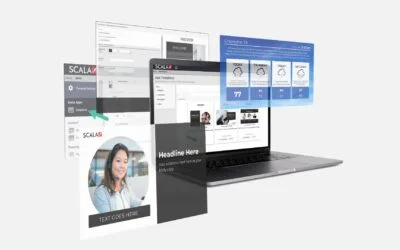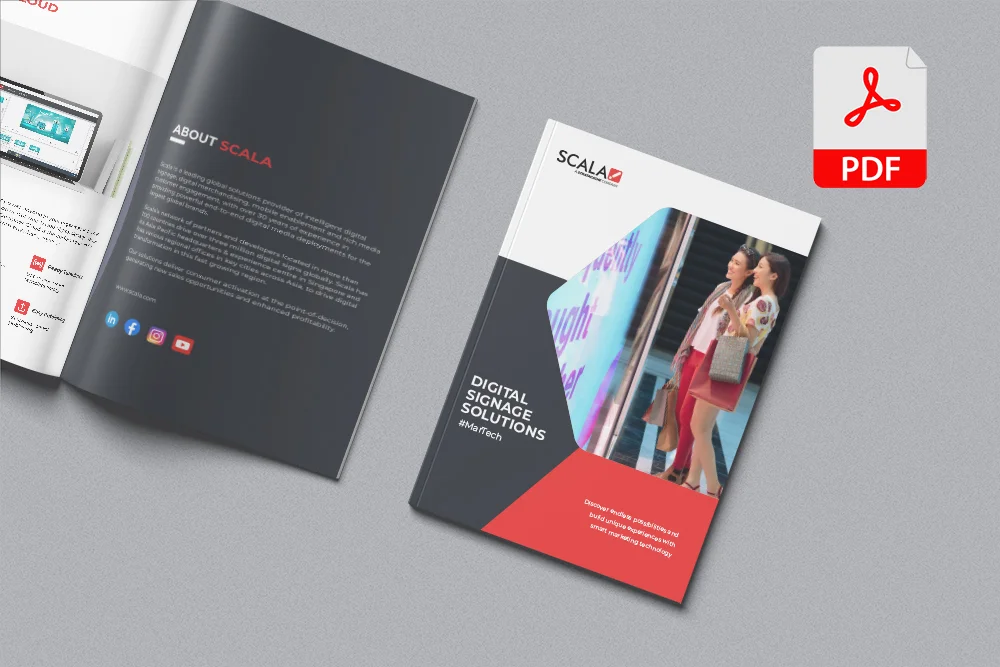How to Improve Passenger Flow in Airport Terminals
by Scala Team
How to Improve Passenger Flow in Airport Terminals
by Scala Team
The International Air Traffic Association estimates the current volume of air traffic will double by 2035. With global air traffic on the rise at such a rapid rate, airports must seek new ways to deliver high quality service and exceptional travel experiences. To ensure travelers continue choosing their airport over others, or alternative transportation altogether, airports can make incremental changes to upgrade their facility.
There are ways to enhance the passenger check-in experience with technology that drives interactive experiences, dynamic messaging, convenience and personalization. Being proactive in preparing travelers for their journey — via details like flight status, time to gate, security information and current weather at their destination — creates a more enjoyable experience for passengers at the airport.

Why Does Passenger Flow Matter?
With air traffic increasing, airport operators who cannot expand their infrastructures due to environmental issues, space restrictions or lack of capital must find new approaches to be more efficient and responsive to passenger needs. Airports around the world, from international hubs to small regional airports, are focusing on how to deliver high quality service and a pleasing experience to ensure passengers choose them instead of a competitor airport.
While flight delays and cancellations are often beyond an airport’s control, the ability to get ahead of issues before they derail a passenger’s journey creates a competitive advantage for an airport. Providing the most current information and reducing wait time in lines is essential to create an improved passenger experience.
According to a recent survey, an extra ten minutes spent waiting in a security line reduces a passenger’s spending on retail by 30 percent on average. Thus, managing lines and ensuring a seamless traffic flow through the terminal becomes an important method to generate more non-airline revenue from dining and retail.
Passenger Flow Management Tactics
To deliver the best possible passenger experience, you need a deep understanding of passengers and their journey through your airport.
- When do they arrive?
- How long are they standing in line?
- At what point do they need additional information?
- Where do they spend time once they are past security?
By understanding the traffic flow in your airport terminal, it becomes easy to identify where bottlenecks occur and at what point passengers might require additional information. Conduct measurement studies of passenger wait times in various locations, such as ticketing, security, in-terminal shuttles and taxi and rideshare pickup. Survey guest relations workers about the most common questions they get regarding directions, wait times and travel instructions to determine if additional wayfinding or directional signage will help.
While conducting this kind of user research and measurement process can seem onerous, this simply is not the case. There are a range of technologies to help airports answer these questions and deliver improved outcomes for passengers, partners and their own business. Using measurement sensor technologies, airport operators can monitor passenger volumes, journey times and line times to establish performance baselines, understand passenger habits and improve crowd flow as passengers journey throughout the airport campus. You can even place interactive digital signage in high-flow areas to conduct quick, ten-second passenger satisfaction scores.
With historical data and current situational data in hand, airports can compare forecasted demand to actual conditions to generate new forecasts, and identify potential solutions. This solution provides operators a better understanding of expected passenger flow and early warning of where resources should be deployed to prevent bottlenecks caused by unexpected circumstances.
For example, Walkbase is a software tool that privately and securely analyzes data from a full network of sensors and connected devices. The central analytics platform creates an accurate visualization of passenger dwell and flow through a given airport terminal or facility. This data allows for an improved understanding of airport passenger flow and operational improvements, such as increasing staffing in specific areas or at specific times of day, or improving wayfinding signage or offering interactive digital signage in a given area.
Clear and Efficient Signage for Passenger Flow Management
By using digital signage technology, passengers can quickly locate their gate and time for arrival or departure in even the busiest of airports. By using this technology effectively, airport terminals and waiting areas are able to display messages in real time, with updates occurring as needed for gate changes, shuttle delays and wait times. Updating arrival and departure boards as quickly as possible when information becomes available helps passengers get to where they’re going in an efficient manner.
As digitization and remodeling occur in airports to keep up with traffic increases, digital signage can offer clear and simple wayfinding. When walkways, escalators and elevators are out of service, digital signage can provide detour directions. When a certain project is completed, updating the signage is as simple as logging into a central software tool and implementing the changes. In addition, building automation system data can be used to provide instructions to passengers for managing service outages such as elevators or escalators.
Dynamic messaging can also help with passenger flow and general satisfaction. Next train countdowns and average wait times for security or baggage claim can help make guiding your travelers through the airport as simple as possible, while lessening stress because they know exactly what to expect.
Digital signage can be customized on an almost entirely personal level. FIDS displays highlight flights in the color of the passenger’s choice resulting in less time spent searching for where to head next and more time spent traveling. Messages can be delivered and updated as needed, in multiple languages based upon originating and destination cities of travel.
Choosing a Passenger Flow Management Partner
Every airport terminal is unique, and even two buildings on the same campus can have vastly different needs. There isn’t a one size fits all solution for passenger flow management, and it is virtually impossible to manage on your own. When looking for a partner to enhance your airport operations and improve terminal passenger flow, do not opt for a simple “plug and play” tool that requires hands-on management and isn’t developed specifically for your needs. Seek an experienced partner who can help you develop a unique solution specifically for transportation hubs. The plan should include specific details based on your terminal layout, upcoming construction projects and daily travel volume.
At Scala, we aim to engage directly with you to identify the best digital signage products for your unique situation. If you are ready to take your airport terminal operations into the 21st century with scalable, digital age solutions for your unique needs, we are standing by to help. Let’s talk about your operational challenges and begin identifying solutions.
Sources:
- https://www.iata.org/en/pressroom/pr/2016-10-18-02
- https://www.sita.aero/globalassets/docs/infographics/passengers-in-focus-infographic.pdf
About the Author:
Scala digital signage experts share their experience and thoughts in our blog to provide practical tips and advice for real-world applications. Our team aims to offer interesting content through a variety of formats including long form articles, video logs, interviews and infographics.





